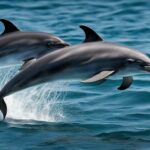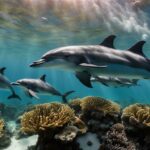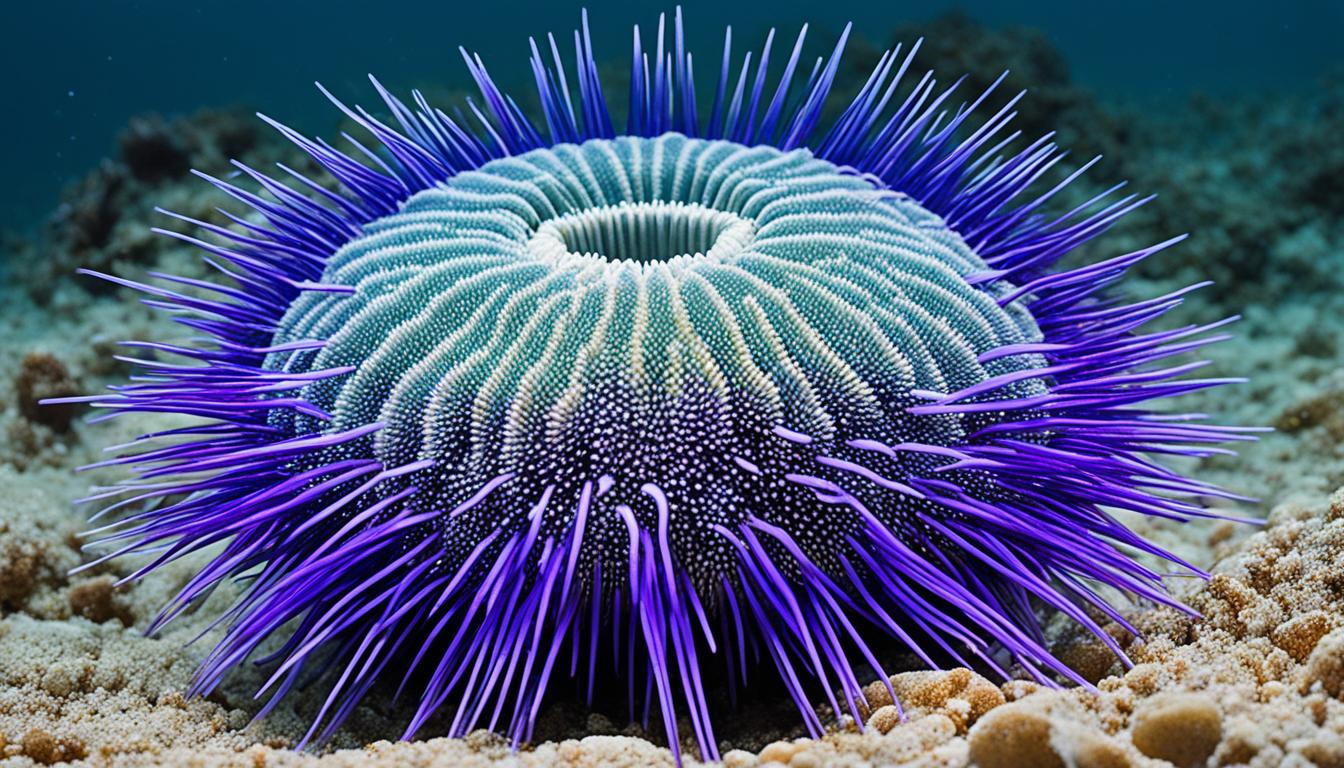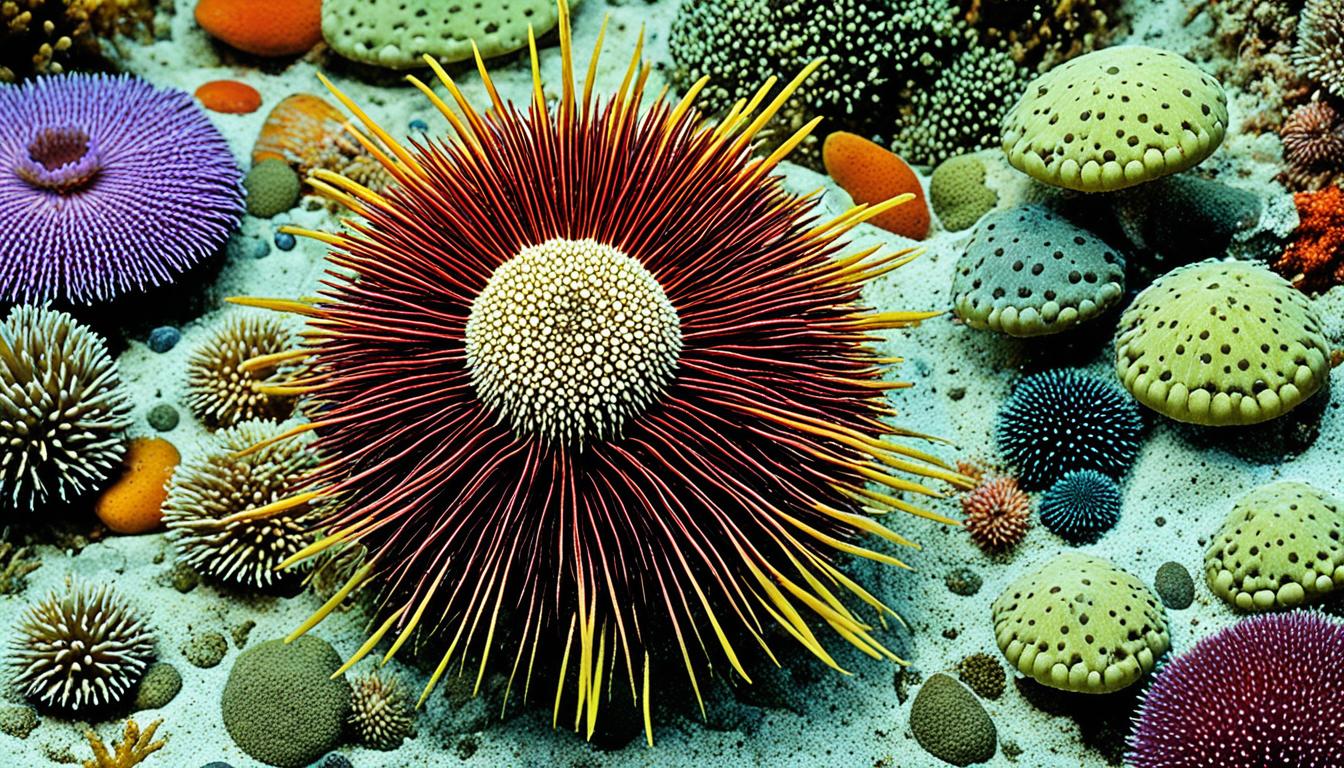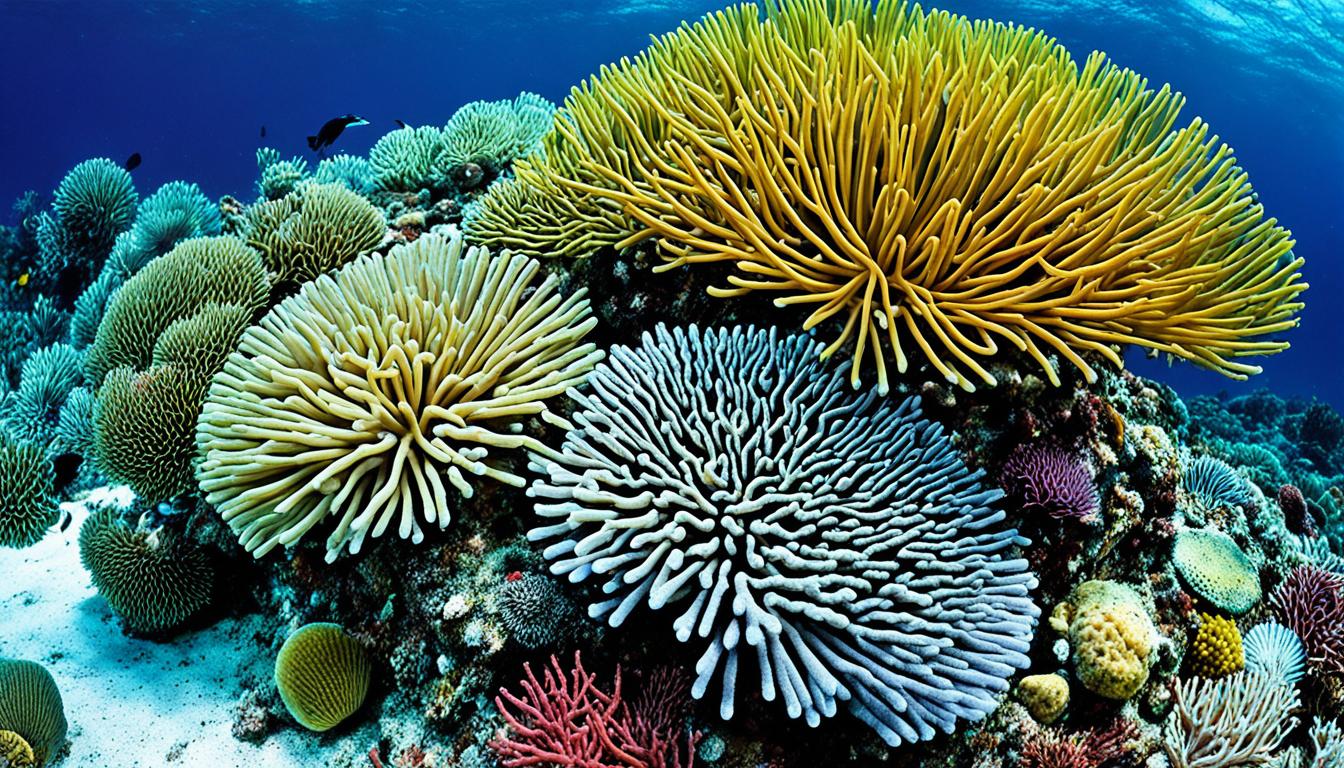Dolphins’ natural habitat is an enchanting realm filled with wonder and awe. These intelligent marine mammals thrive in diverse marine ecosystems, captivating us with their fascinating behavior and captivating interactions. Understanding their natural habitat, behavior, and the importance of dolphin conservation is key to their preservation and the health of marine ecosystems.
In this section, we will delve into the majestic world of dolphins and their marine mammal habitats. We will explore the intricate details of their behavior, including how they communicate, hunt, and socialize within their natural environment. By gaining insight into their unique role within marine ecosystems, we can appreciate the significance of their conservation and the conservation measures being taken to protect these remarkable creatures.
Additionally, we will expand our scope to explore various marine mammal habitats worldwide. From coastal areas to oceanic habitats, these diverse environments support a wide range of aquatic wildlife beyond just dolphins. The beauty and vulnerability of marine ecosystems will take center stage, emphasizing the importance of conservation efforts in preserving the delicate balance of marine biodiversity.
Moreover, we will highlight the dolphin programs offered at Sea Life Park, providing an opportunity for participants to learn about and interact with dolphins in their natural habitat. The Dolphin Exploration program immerses enthusiasts in a hands-on experience with the dolphins in deep water. Alternatively, the Dolphin Encounter program allows participants to observe the dolphins from a waist-deep platform, venturing into slightly deeper water if comfortable. The Dolphin Aloha program offers a close-up interaction with dolphins without entering the water. Each program has certain restrictions and requirements, ensuring the safety and well-being of both participants and the dolphins.
By promoting dolphin conservation and offering these interactive programs, Sea Life Park not only provides an unforgettable adventure but also contributes to the education and appreciation of these magnificent creatures. So, get ready to dive into the breathtaking world of dolphins and embark on a deep-sea adventure like no other!
Understanding Dolphin Behavior in Their Natural Habitat
Dolphins exhibit a wide range of behaviors that are perfectly adapted to their natural habitat. These intelligent marine mammals display remarkable communication skills, using a combination of clicks, whistles, and body movements to interact with each other and navigate their surroundings. They also demonstrate exceptional hunting abilities, employing cooperative strategies to catch their prey in the vast expanse of the ocean.
One fascinating behavior observed in dolphins is their affinity for socializing. They form intricate social structures, living in pods that range in size from a few individuals to hundreds. Within these pods, dolphins engage in various social behaviors, including cooperative hunting, caring for young calves, and even playful interactions such as leaping and tail-slapping.
It is believed that these behaviors not only facilitate survival but also strengthen social bonds within the pod. Dolphins’ adaptability and ingenuity in adapting to their natural habitat are key factors in their remarkable success as marine mammals.
The Significance of Dolphin Conservation
Conservation initiatives play a crucial role in safeguarding dolphins and the delicate balance of their natural habitat. Dolphins are not only fascinating creatures but also key indicators of the health of marine ecosystems. By protecting dolphins, we ensure the preservation of marine biodiversity and the overall well-being of our oceans.
One of the primary threats faced by dolphins is habitat loss and degradation. As coastal development and human activities continue to expand, valuable marine habitats are being destroyed, leaving dolphins with limited areas to thrive. Conservation efforts focus on preserving these habitats by establishing protected areas, implementing sustainable fishing practices, and raising awareness about the importance of responsible tourism.
The beauty and vulnerability of dolphins captivate our hearts, reminding us of the interconnectedness of all living beings and the need to protect our oceans for future generations.
Another significant aspect of dolphin conservation is addressing the numerous human-induced threats they encounter. Pollution, including plastic waste and chemical contaminants, poses a severe risk to dolphins and other marine life. Through education and advocacy, conservation organizations aim to reduce pollution, promote recycling, and encourage the use of eco-friendly products.
Table of Dolphin Conservation Programs at Sea Life Park:
| Program Name | Description | Requirements |
|---|---|---|
| Dolphin Exploration | A hands-on experience with dolphins in deep water | Minimum age: 8 years old. Adult supervision required for children. |
| Dolphin Encounter | Observation of dolphins from a waist-deep platform with the option to move into deeper water | Minimum age: 1 year old. Adult supervision required for children. |
| Dolphin Aloha | Close-up interaction with dolphins without entering the water | Minimum age: 1 year old. Adult supervision required for children. |
At Sea Life Park, we offer various interactive programs that allow participants to explore dolphins’ natural habitat while providing educational insights into their physiology, conservation, and care. These programs offer unique opportunities to connect with dolphins and develop a deeper appreciation for their importance in our marine ecosystems.
When participating in these programs, it is essential to follow safety guidelines and arrive on time. To ensure a memorable experience, Sea Life Park provides safety vests and emphasizes the use of biodegradable sunscreen. Reservations for the interactive programs are required, and any cancellations must be made at least 48 hours in advance. Park admission is included in the program fees, allowing visitors to enjoy all the park has to offer after their dolphin encounter.
Exploring Marine Mammal Habitats Around the World
Marine mammal habitats encompass a vast array of ecosystems, each with its own unique characteristics and inhabitants. From the coastal areas teeming with marine life to the expansive oceanic habitats that stretch across vast distances, these habitats provide a home for a wide variety of aquatic wildlife. Let’s dive deeper into the diverse marine mammal habitats found around the world.
Coastal Areas
Coastal areas are known for their rich biodiversity and abundant marine mammal populations. These habitats, where the land meets the sea, are often characterized by a mix of rocky shores, sandy beaches, and shallow waters. They provide an ideal environment for marine mammals like seals, sea lions, and otters.
In these coastal habitats, marine mammals can find ample food sources, such as fish, crustaceans, and mollusks. The rugged coastlines also offer protected areas for breeding, giving birth, and raising their young. The intertidal zones, where the water meets the land, provide a diverse range of habitats that support a variety of marine life.
Oceanic Habitats
As we move further away from the coastline, we encounter the vast expanse of oceanic habitats. These open waters cover a significant portion of the Earth’s surface, and they are home to some of the largest and most magnificent marine creatures, including whales, dolphins, and porpoises.
Within the oceanic habitats, there are distinct zones characterized by depth and distance from the shore. The pelagic zone, which extends from the surface to the deep waters, is where many marine mammals can be found. They rely on the abundance of food sources, such as plankton, squid, and small fish, found in these nutrient-rich waters.
Deep in the oceanic habitats, where light diminishes and pressures increase, fascinating creatures like sperm whales and beaked whales roam the depths. These mammals have adapted to the extreme conditions, diving to great depths in search of food and utilizing unique hunting techniques.
| Marine Mammal | Coastal Areas | Oceanic Habitats |
|---|---|---|
| Seals | ✓ | |
| Sea Lions | ✓ | |
| Otters | ✓ | |
| Whales | ✓ | |
| Dolphins | ✓ | |
| Porpoises | ✓ |
As we explore marine mammal habitats around the world, it is essential to recognize the significance of these environments for the survival and well-being of these remarkable creatures. Conserving and protecting these habitats is crucial to maintaining the delicate balance of our marine ecosystems and ensuring the continued existence of marine biodiversity.
The Beauty and Vulnerability of Marine Ecosystems
Marine ecosystems are captivating environments teeming with life, but they are also fragile and in need of protection. These intricate habitats encompass a vast array of species, from colorful coral reefs to majestic whales, creating a diverse and vibrant underwater world.
The delicate balance of marine ecosystems is crucial for the survival and well-being of countless marine species. Coral reefs, for instance, act as nurseries and shelter for numerous fish species, supporting the intricate food webs that sustain life beneath the waves. These underwater forests also provide protection from coastal erosion, mitigating the impact of storms and ocean currents.
However, marine ecosystems face significant threats from human activities, such as pollution, overfishing, and climate change. Pollution, including plastic debris and chemical contaminants, poses a grave danger to marine life, leading to entanglement, ingestion, and habitat destruction. Overfishing disrupts the delicate balance of marine food webs, causing population declines and the collapse of fish stocks. Additionally, climate change-induced rising sea temperatures and ocean acidification jeopardize the survival of coral reefs, impacting the entire ecosystem.
The Importance of Marine Conservation
“The sea, once it casts its spell, holds one in its net of wonder forever.” – Jacques Yves Cousteau
Marine conservation plays a vital role in preserving the beauty and diversity of these vulnerable ecosystems. It aims to restore and protect marine habitats, promote sustainable fishing practices, and raise awareness about the importance of marine biodiversity. Conservation efforts can help mitigate the damage caused by human activities and ensure the long-term survival of marine species.
By implementing marine protected areas, where fishing and other extractive activities are limited or prohibited, we can give marine ecosystems a chance to recover and thrive. These protected zones act as sanctuaries for marine life, allowing for the regeneration of critical habitats and the preservation of biodiversity. Furthermore, promoting sustainable fishing practices, such as implementing catch limits and using selective fishing gear, can help prevent overfishing and maintain healthy fish populations.
As Jacques Yves Cousteau beautifully stated, the sea holds an undeniable charm and wonder. By actively participating in marine conservation, we can ensure that future generations will continue to be enchanted by the captivating beauty of marine ecosystems and the diverse array of life they support.
Table: Marine Ecosystems in Peril
| Threats | Impact |
|---|---|
| Pollution | Habitat degradation, species extinction |
| Overfishing | Imbalance in food webs, fish population decline |
| Climate Change | Coral bleaching, habitat loss, species migration |
Dolphin Programs at Sea Life Park
Sea Life Park offers a range of interactive programs designed to provide a unique and educational experience with dolphins in their natural habitat. These programs allow participants to immerse themselves in the world of dolphins and learn about their physiology, conservation, and care.
“The Dolphin Exploration program provides a hands-on experience with the dolphins in deep water, while the Dolphin Encounter program allows participants to observe the dolphins from a waist-deep platform and move into slightly deeper water if comfortable,”said a spokesperson from Sea Life Park. These programs offer an opportunity to witness the intelligence and beauty of dolphins up close, while knowledgeable trainers provide insights into their behavior and the importance of marine mammal habitats.
The Dolphin Aloha program is another option, allowing visitors to have a close-up interaction with dolphins without entering the water. This program is ideal for those who prefer to stay dry but still want to experience the charm and playfulness of these incredible creatures.
Please note that certain restrictions and requirements apply to these programs. There is a minimum age requirement, and adult supervision is necessary for younger children. It’s important to arrive on time and follow all safety guidelines to ensure a safe and enjoyable experience for everyone.
Sea Life Park emphasizes the use of biodegradable sunscreen and provides safety vests for participants. Reservations are required for the interactive programs, and cancellations must be made at least 48 hours in advance. The fees for these programs include park admission, allowing participants to explore other exhibits and attractions during their visit.
| Program | Description | Requirements |
|---|---|---|
| Dolphin Exploration | Hands-on experience with dolphins in deep water. | Minimum age requirement |
| Dolphin Encounter | Observation of dolphins from a waist-deep platform, with the option to move into slightly deeper water. | Minimum age requirement, adult supervision for younger children |
| Dolphin Aloha | Close-up interaction with dolphins without entering the water. Ideal for those who prefer a dry experience. | Minimum age requirement, adult supervision for younger children |
What Can We Learn About Dolphins’ Social Behavior and Dynamics Through Exploring Their Natural Habitat?
What Can We Learn About dolphins’ social behavior and dynamics Through Exploring Their Natural Habitat? Studying dolphins’ social behavior and dynamics in their natural habitat offers valuable insights into their complex societal structure. Observing them interact in their social groups provides a deeper understanding of their communication patterns, alliances, hierarchical systems, and cooperation strategies. Exploring their natural habitat allows researchers to witness firsthand the intricacies that shape dolphins’ social behavior and dynamics, facilitating the preservation and conservation of these extraordinary marine creatures.
Conclusion
Immerse yourself in the wonders of dolphins’ natural habitat and embark on a journey that will leave you with a newfound appreciation for the beauty and importance of our oceans. By exploring the behavior of these majestic creatures and understanding the significance of dolphin conservation, you will gain a deeper understanding of the delicate marine ecosystems they call home.
At Sea Life Park, you have the opportunity to take part in interactive programs that allow you to get up close and personal with dolphins in their natural habitat. The Dolphin Exploration program offers a hands-on experience, where you can interact with dolphins in deep water and learn about their physiology, conservation, and care. If you prefer a more observational experience, the Dolphin Encounter program allows you to observe the dolphins from a waist-deep platform, with the option to move into deeper water if comfortable.
The Dolphin Aloha program provides a close-up interaction with dolphins without entering the water. Each program has certain restrictions and requirements, including minimum age and adult supervision for younger children. It is important to arrive on time and follow the safety guidelines provided by the park. Biodegradable sunscreen is recommended, and safety vests are provided for participants.
Reservations are required for the interactive programs, and cancellations must be made at least 48 hours in advance. The program fees include park admission, allowing you to explore the wonders of Sea Life Park and further appreciate the incredible marine biodiversity found within its borders. So don’t miss out on this extraordinary opportunity to connect with dolphins and contribute to their conservation efforts!





